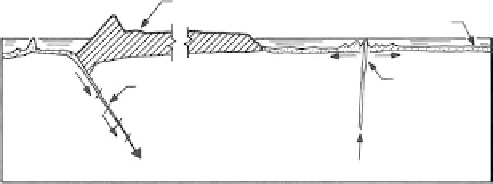Environmental Engineering Reference
In-Depth Information
Continental crust
Seafloor
Upwelling
magna and
spreading
seafloor
Earthquake
foci along
subducted zone
Mantle
FIGURE 11.2
The concept of a subducting plate and the
spreading sea floor. (From Deitz and
Holden, 1970.)
Subducting
plate
To 700 km
TABLE 11.1
Important Earthquakes of the World
Location
Date
Magnitude
a
Importance
Corinth, Greece
856
45.000 dead
Chihli, China
1290
100,000 dead
Shensi, China
1556
830,000 dead
Three Rivers, Quebec
Feb. 5, 1663
Strongest quake, NE North America (est. I
X)
Calcutta, India
1737
300,000 dead
Lisbon, Portugal
Nov. 1, 1755
≈
8.7
60,000 dead; caused large tsunamis, and seiches
in lakes to distances of 3500km
Calabria, Italy
Feb. 5, 1788
50,000 dead
New Madrid, Missouri
Dec. 16, 1811
≈
8
Three great quakes occurred in this period
and Feb. 7, 1812
that affected an area of over 8000 km
2
and
caused large areas to subside as much as 6m
Charleston, South Carolina
Aug. 31, 1886
≈
8
Large-magnitude shock in low-seismicity area
San Francisco, California
Apr. 18, 1906
≈
8.3
About 450 dead, great destruction, especially
from fire. San Andreas fault offset for
430 km or more; one of the longest surface
ruptures on record. First “microzonation
map” prepared by Wood
Colombia-Ecuador border
Jan. 31, 1906
8.9
Largest magnitude known, in addition to one
in Japan, 1933
Messina, Italy
Dec. 28, 1908
7.5
120,000 dead
Kansu, China
Dec. 16, 1920
8.5
200,000 dead or more. Perhaps the most
destructive earthquake. Entire cities
destroyed by flows occurring in loess
Tokyo, Japan
Sept. 1, 1923
8.2
The Kwanto earthquake; 143,000 dead,
primarily from fires
Attica, New York
Aug. 12, 1929
7.0
Largest recent event in NE United States and
eastern Canada
Grand Banks,
Nov. 18, 1929
≈
7.5
Undersea quake caused turbidity currents
Newfoundland
which broke 12 undersea cables in
28 locations
Long Beach, California
Mar. 10, 1933
6.3
Small shock caused much destruction to poorly
designed and constructed buildings. Resulted
in improved building code legislation
regarding schools. First shock recorded
on an accelerograph
Quetta, India
May 30, 1935
7.5
30,000 dead
Western Turkey
Dec. 26, 1939
8.0
20,000 to 30,000 dead
El Centro, California
May 18, 1940
6.5
The Imperial valley event. The first quake to
provide good strong motion data from an
accelerograph. Provided the basis for seismic
design for many years
Kern Co., California
July 21, 1952
7.7
First major shock in California after
earthquake-resistant construction began;
showed the value of resistant design
(Continued)


